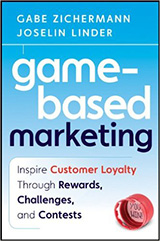My notes on “Game-based Marketing: Inspire Customer Loyalty Through Rewards, Challenges and Contests” by Gabe Zichermann & Joselin Linder.
Games are all around us
- “The Subway Game” is passive – most people don’t realise there is a game on, the players stand close to the train doors, block other players with their body language and compete for a seat. Breaking the rules using aggression is not allowed.
- Variations: The Bar Game – get to the bar and order drinks for your friends the fastest. The Supermarket Game – identify which queue is likely to move the quickest
- They are big business. Games such as Frequent Flier Miles earn more revenue for airlines than flying people around
The 4 Components of “Funware”
Status and Levels
- Status is an outward display of achievement. Levels are a convenient way to divide play into achievable subgames while also creating status shorthand. They are frequently interchangeable and invariably go hand-in-hand
- Eg: First class lounges
Points
- For scorekeeping and comparisons in a leaderboard.
- Eg Facebook friend count
Rules
- Without rules their would be chaos. The rules may be explicit or unarticulated
- Eg you can’t barge someone out of the way in the Subway game or you’ll get yelled at
Demonstratability
- Sitting in a VIP section in a club would be less fun if no one saw you there. If it’s demonstrateable it is delivering power and status
The 4 Player Types
Achievers (Diamonds)
- Driven by a desire to get points, achieve goals, and hit their mark
- Go to great lengths to acquire points and prestige
- Thorough game players
- Favour games that appreciate and reward them for completing tasks
- Games must be winnable with an end point
- They require an audience (of Socialisers) to appreciate their accomplishments. Social networks and leaderboards are essential
Socialisers (Hearts)
- Play to connect with other players, rather than to demonstrate skill
- Will play just about anything that can be played in groups
- May play, and may just watch
- Have lots of online friends to spread the word about games they love
Explorers (Spades)
- Map out their environment. The richer the virtual world, the better
- Like random puzzles, side stories and accumulating obscure badges and points
- May set their own rules and challenges
- Enjoy sharing detailed and unusual information they have uncovered
- It’s about the journey, not the destination
Killers (Clubs)
- Like to win (and ensure that others lose)
- Hurting others brings them joy
- Punishing weak players / newbies is especially enjoyable
- They crave respect and power
No more gender gap
- There is no longer a gender gap, although women do prefer to play games on phones or computers rather than consoles
Pleasure today or pain tomorrow?
- They have profoundly changed our choices about what to do with our free time. Would you prefer to:
- Watch TV
- Read a book
- Do your taxes
- Or play your favourite game with your friends?
- Pleasure today is more valuable than pain tomorrow, so could game/fun elements be introduced into mundane tasks?
Badges & Levels incentivise play
- Newbie badges nudge new players through the initial stages of the game eg “invite 3 friends to join” or “complete your profile now” to receive badges early
You should always hide the true dollar value of your points
- This gives you freedom of increasing/decreasing the cost of a point to you
- Promotions are easier
- 1 million points sounds more impressive than 100 points
- People lose track of how much a point is worth (this is in your favour)
- You might be able to build an entire virtual economy. Many games offer shortcuts to acquiring upgrades (like weapons/armour) by buying points with real world money and then using those points to buy items in the game
How Leaderboards Stimulate Play
- Leaderboards allow players to compare their performance to friends and strangers
- No active game exists for the number of Facebook friends you have… yet, but we can’t help but assemble a leaderboard in our heads
- Leaderboard examples: “7 days since a deaths on our construction site”, “The Employee of the Month is…”
- The key is, what action do we want to motivate people to take? For games it’s often “to play more”
- Lots of levels is good, so there is increased competition and rivalry for the players in each level. Otherwise, the people at the bottom may lose hope when they see how far they are from the leaders. Eg a frequent flier with 5,000 air miles per annum can’t compete with a player that does 100,000 per annum
Could you introduce game elements into your workplace?
- In Gordon Ramsey’s Kitchen Nightmares, a restaurant was losing profit by wasting a lot of food and disappointing other customers by over-selling certain dishes. Gordon offered a $100 prize to the first waiter who could sell at least one of every item on the menu in a night. The Result: No oversold items and no leftovers.
- How can you introduce challenges and rewards?

Those last 2 points are great. I always get stuck on thinking of customers playing the game and forget that staff members can play as well. Not relevant for me yet (staff) but hopefully it will be in the future.
Yes! Thanks Bradley